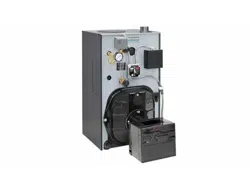Loading ...
Loading ...
Loading ...

Part number 550-142-330/0421
33
SGO
OIL-FIRED NATURAL DRAFT STEAM BOILER — SERIES 4 — Boiler Manual
SERVICETECHNICIANONLY—readandfollowcompletely.
Start up –
Steam Boiler Water Treatment
Steam Heating Installation Considerations
Closed steam heating systems should not have high amounts
of make-up water. Make-up water only occurs when the system
is leaking or when make-up water is incorrectly administered.
And, even with chemical treatment, make-up water will reduce
boiler life due to corrosion. And chemical treatment may be dif-
ficult to execute if the system make-up volume is unpredictable.
Troubleshoot the system BEFORE considering water treatment.
If the system is using make-up water, then the following may be
likely:
•Leakingreturnlines, underground pipes, faulty steam traps,
faulty air vents
•Automaticwaterfeedisinstalledincorrectlyorincorrectly
adjusted
•Ifthesystemutilizesacondensatereceiver,thefeedermay
be flooding due to long system time lag.
If the piping is NOT leaking, consider installing a boiler feed
system (NOT a condensate return system). The boiler feed
system provides condensate storage and allows the boiler to
directly control water level. This is not the case with gravity
return systems or condensate return systems — these only
provide water to the boiler when the condensate returns from
the system. If the system time lag is longer than boiler can
provide steam, and the boiler is equipped with an automatic
feeder, water will feed to the boiler before the condensate can
return from the system. This will cause overfill and flooding
when the condensate does return. Also, pumping cold make-up
water directly into the boiler collapses the water level, causing
false indications of need for make-up. With a boiler feed system,
the float control on the boiler turns the feed pump on and off as
needed. Make-up water is added at the boiler feed system tank.
And the storage volume of the tank makes it unlikely that make-
up will be needed UNLESS there is a system leak.
Chlorides
Over the last several decades, the level of chlorides in some
ground water and city water supplies have increased due to
use of salt during the removal of snow and ice from roads and
highways, and the increased use of water softeners. Elevated
levels of chlorides (over 200 ppm) in the water of steam boilers
will accelerate water side corrosion and shorten the operating
life of the boiler.
Chlorides and other dissolved solids are present in boiler make-
up water and are not removed from the boiler when the boiler
is producing steam. The level of chlorides and dissolved solids
in the boiler water increase when make-up water is added to the
boiler because of normal maintenance to low water cutoffs and
system leaks. If there are high chloride and dissolved solid levels
in boiler make-up water, boiler water treatment should be con-
sidered.
In general, cast iron steam boilers do not require water treatment
for protection. However, some boiler water treatment chemi-
cals can promote water level instability. Surging and priming in
steam boilers can result even though the boiler was thoroughly
cleaned before the treatment was added.
Systems where treatment should be
considered are:
•Processapplications
•Contaminatedcondensate
•Largemake-upwaterrequirements
•Systemcomponentsrequiringcorrosioninhibitor
•Extremelyhardwater
•Make-upwatersupplywithhigherthan30ppmofchloride
Beware the Foam
Water treatment chemicals should be thoroughly reviewed be-
fore they are introduced into the boiler and heating system. Of
particular concern are foaming agents that will interfere with
the disengagement of the steam at the boiler waterline. For this
reason, foaming agents cannot be tolerated in steam boilers.
Testing & Treatments
To test the boiler water treatment chemicals, prepare a small
amount of the chemical intended for the boiler with water. In a
ventilated area, put this mixture into a pan and bring to a “roll-
ing boil” on the stove. If the mixture foams, it is not suitable
for the boiler.
Recognized treatment compounds used for oxygen scaveng-
ing and corrosion protection should not affect the life of the
elastomer sealing rings. Asking the treatment supplier to test
a sealing ring in the proposed compound can eliminate any
doubt. In any case, a compound containing petroleum should
not be used.
Without Chemical Treatment
•When the chloride level is above 400 ppm, or the total dis-
solved solids (TDS) are above 1000 ppm, drain and refill the
boiler with fresh water and bring the boiler to pressure for
15 minutes per the boiler manual to drive off excess oxygen.
•If chemical treatment is not used and chloride level and
TDS levels are not monitored, drain and refill the boiler
when the chloride level is above 400 ppm, or the total dis-
solved solids (TDS) are above 1000 ppm. After refilling the
boiler, bring the boiler to pressure for 15 minutes per the
boiler manual to drive off excess oxygen.
These steps will help prevent corrosion caused by high conductivity,
but may not prevent under-deposit corrosion.
In general, cast iron steam boilers do not require water treatment
for protection. However, some water conditions may require
the boiler be drained and refilled, or in more aggressive areas,
chemically treated.
Loading ...
Loading ...
Loading ...
